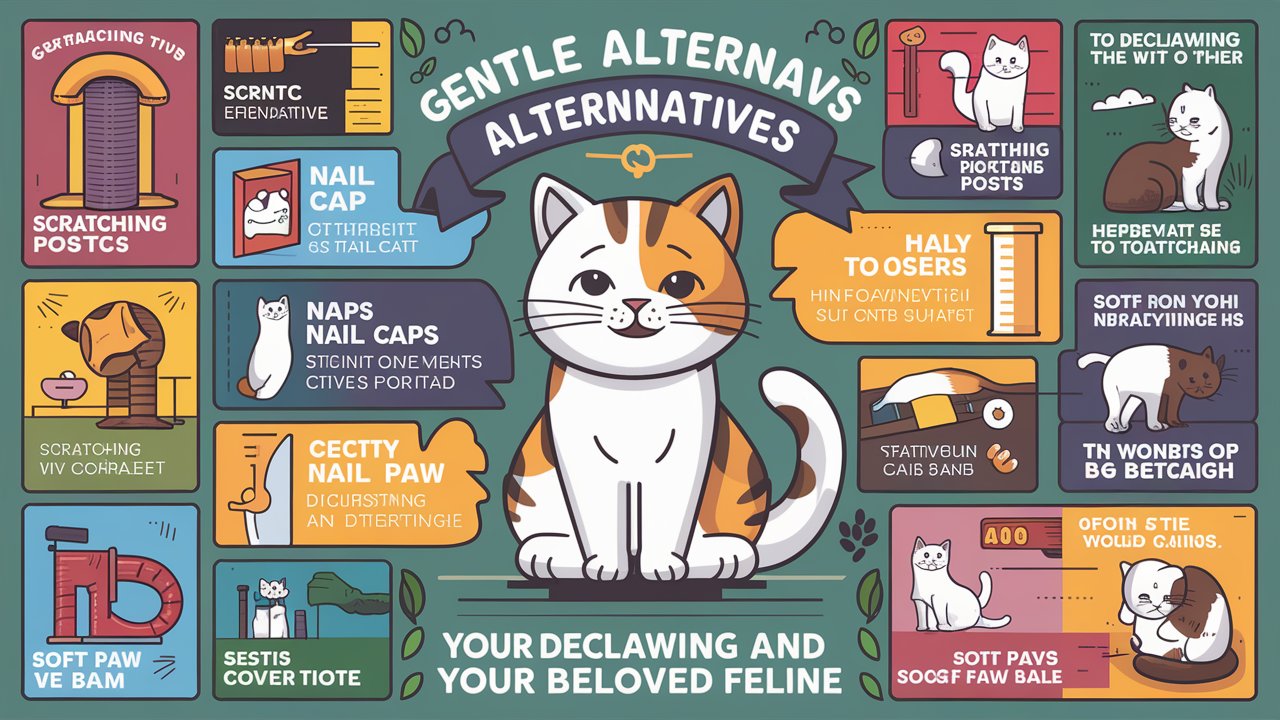In a world where pets are cherished members of our families, the ethical considerations surrounding their well-being hold immense weight. Among the myriad decisions pet owners face, the act of declawing felines stands as a pivotal moment where traditional practices clash with modern ethics.
As guardians of our beloved furry companions, it is imperative to pause and reflect on the significance of preserving not just their physical form but also their emotional and behavioral integrity. The journey towards responsible pet ownership unveils a landscape rich with gentle alternatives, offering us an opportunity to navigate uncharted territories thoughtfully and compassionately.
We invite you into a realm brimming with empowerment and possibility—an exploration into eight gentle alternatives to declawing your treasured feline companion. Through an open-minded lens, we delve deep into the intricacies of cat care, reigniting our commitment to holistic well-being for our whiskered friends.
With resourceful guidance at your fingertips and a playful spirit guiding our approach, let us embark on this enlightening journey together—one that celebrates diversity in perspectives while arming you with practical tools to sculpt a harmonious existence for both you and your purring confidant.
Dive in as we paint a canvas vibrant with solutions, ripe with promise, and beckoning you to embrace change grounded in empathy and enlightenment.
Scratching Posts.
Your feline friend’s desire to scratch isn’t a call for destruction but rather an instinct that can be channeled in a positive way. Scratching posts are a cat’s paradise, offering numerous benefits beyond saving your furniture from becoming shredded remnants.
By incorporating scratching posts into your cat’s environment, you’re providing them with an outlet for stretching their muscles, sharpening their claws, and marking their territory – all essential behaviors for their well-being.
To ensure your kitty falls in love with their scratching post kingdom, consider the texture and height of the post. Some cats prefer sisal rope while others fancy carpeted posts, so providing a variety will cater to different preferences. Strategically placing these posts near areas where your cat likes to scratch will encourage the transition from furniture to scratching post.
Jenny, a devoted cat parent, shared how her mischief-maker Snowball shifted from using her couch as a scratching canvas to vigorously clawing at the new sisal-covered scratching post placed strategically by the living room window.
Success stories like Jenny and Snowball’s are testaments to the power of redirection and choice in alternatives. These fur-parents took charge of transforming destructive habits into constructive ones by empowering their feline companions with suitable options like scratching posts.
Remember, understanding your cat’s natural instincts is key; by embracing diverse perspectives and considering what works best for your particular furball, you embark on a journey towards harmonious cohabitation filled with playful antics and satisfied purrs.
Nail Trimming: A Painless Path to Paw Care.
Proper nail trimming is a simple yet crucial step in safeguarding your furniture and cat’s well-being without resorting to declawing. This alternative not only prevents damages but also fosters a bond through regular grooming routines.
To embark on this empowering journey, consider investing in high-quality tools like cat-specific nail clippers or grinders for safe and efficient trimming at home. These resources equip you to confidently tackle nail maintenance without the need for invasive procedures.
Many cat owners have discovered the benefits of mastering the art of at-home nail trimming. By sharing their success stories, they inspire others to embrace this gentle approach with open minds.
Testimonials reveal how cats quickly adapt to the routine, leading to fewer incidents of unwanted scratching behavior. Through these anecdotes, readers can witness firsthand the positive impact nail trimming can have on both their furniture and feline companions.
Incorporating regular nail trimming into your cat’s care routine can transform what might seem daunting into a playful and rewarding experience. By demystifying this essential practice and offering practical guidance, cat owners are equipped to navigate paw care confidently.
Let these insights spark curiosity and pave the way toward exploring alternatives that prioritize your beloved pet’s health and happiness while preserving your home decor intact.
Soft Paws Caps: A Fashionable and Gentle Solution.
Soft Paws caps are revolutionizing the world of cat care, offering a stylish and gentle alternative to declawing. These innovative caps provide a humane way to protect your furniture while keeping your feline friend happy and healthy. Emphasizing their non-invasive nature, Soft Paws caps are designed to fit over your cat’s claws, preventing damage caused by scratching without affecting their natural behavior.
One of the key benefits of Soft Paws caps is that they allow normal nail retraction, ensuring that your cat can still engage in regular scratching activities without causing harm.
Applying these caps at home is a straightforward process, thanks to the user-friendly kits available in various sizes and colors. Simply trim your cat’s nails, fill each cap with adhesive, and gently slide them onto the claws for a purrfect fit.
Many cat owners have shared heartwarming success stories after introducing Soft Paws caps to their furry companions. One delighted owner mentioned how her once-destructive kitty transformed into a model housemate with the help of these colorful nail covers.
With Soft Paws caps, you’re not just protecting your furniture – you’re also promoting positive bonding experiences with your feline friend through stress-free playtime and interaction.
By incorporating Soft Paws caps into your cat care routine, you’re making a compassionate choice that aligns with responsible pet ownership principles. Say goodbye to worries about scratched surfaces and hello to a harmonious living space where both you and your beloved feline can coexist peacefully.
Let Soft Paws be the stylish solution that empowers you to explore gentler alternatives and enhance the well-being of your cherished companion.
Positive Reinforcement Training: Shaping Your Cat’s Behavior with Love and Rewards.
Positive reinforcement training stands out as a beacon of hope in redirecting your feline friend’s destructive scratching behavior towards a path of positive habits. Through the magic of rewards and encouragement, this method empowers cat owners to guide their pets gently towards more appropriate scratching outlets.
Strategies like clicker training, where the sound of a clicking device is associated with desired behaviors followed by treats or praise, can work wonders in fostering new habits among our purring companions.
Imagine the heartwarming tale of Whiskers, a once-skeptical tabby who transformed into an exemplary model with the power of positive reinforcement. By consistently rewarding Whiskers for using his scratching post instead of the couch, his owner witnessed a remarkable turnaround.
Through patience and understanding, they were able to witness firsthand how small gestures can lead to significant changes in feline behavior. It wasn’t just about teaching Whiskers not to scratch furniture; it was about building trust and rapport through shared victories.
From playful bops on the nose to delicious treats reserved for post-scratching routines, positive reinforcement creates a delightful environment where learning becomes an exciting adventure rather than a chore.
This technique not only enriches the bond between pet and owner but also unlocks endless possibilities for growth and mutual understanding. By sharing stories like Whiskers’, we aim to inspire cat owners everywhere to explore these gentle alternatives wholeheartedly, knowing that every small step forward is a victory worth celebrating in the journey towards harmonious cohabitation with beloved felines.
Environmental Enrichment: Creating a Fulfilling Environment for Your Feline Companion.
Imagine your cat leaping through the air, chasing after a feather toy with eyes widened in excitement. Environmental enrichment is not just a trend but an essential component of ensuring your feline friend leads a happy and healthy life.
By incorporating interactive toys, climbing structures, and daily play routines into their environment, you’re setting the stage for mental stimulation that can significantly reduce stress-related scratching behaviors.
One cat owner, Sarah, shared her experience of transforming her apartment into a kitty wonderland filled with enriching activities. By introducing puzzle feeders that required her cat to work for treats and providing various climbing perches near windows, she witnessed a remarkable change in her cat’s behavior.
The once restless scratcher became more relaxed and content as he spent his time engaging with new stimuli around him.
It’s not just about distracting your pet; it’s about offering them opportunities to explore their instincts in constructive ways. Whether it’s dedicating playtime each day to bond with your cat through interactive games or investing in a multi-level cat tree that allows them to survey their kingdom from above, environmental enrichment opens doors to healthier habits and happier cats.
Countless owners have noticed their feline companions become more at peace with themselves and their surroundings simply by enriching their living spaces with meaningful activities and structures designed specifically for them.
Consultation with Veterinarian or Behaviorist.
When faced with the challenge of your beloved feline’s excessive scratching, turning to professional guidance from veterinarians or animal behaviorists can be a game-changer in finding gentle alternatives to declawing.
These experts possess a wealth of knowledge on cat behavior and welfare, allowing them to tailor advice specific to your cat’s individual needs. Seeking their assistance empowers cat owners to delve into a realm of solutions that prioritize both the well-being of their pets and the harmony within their homes.
Imagine a scenario where a concerned cat owner named Emily consulted with a skilled animal behaviorist regarding her cat’s incessant scratching issues. Through insightful observations and thorough analysis, the behaviorist recommended implementing environmental enrichment strategies combined with positive reinforcement training tailored to Emily’s cat’s preferences.
Within weeks, Emily noticed a remarkable shift in her cat’s behavior – from destructive scratching to engaging enthusiastically with new scratching posts and interactive toys provided based on the expert’s advice.
Highlighting successful cases like Emily’s showcases how veterinary consultation can lead to discovering effective alternatives that not only address scratching problems but also strengthen the bond between cats and their owners.
By sharing these narratives, pet owners are inspired and equipped with practical examples of how expert guidance can bring about transformative changes in their furry companions’ habits.
Ultimately, consulting with professionals opens up avenues for proactive solutions that cater to each cat’s unique personalities and needs, fostering an environment of understanding and growth for both humans and felines alike.
Natural Cat Deterrents: Keeping Your Furniture Safe and Your Feline Happy.
As responsible pet owners, it’s essential to find humane ways to discourage unwanted scratching behavior in our feline companions. Natural cat deterrents offer a gentle yet effective solution to protect your furniture while promoting positive scratching habits for your beloved cat.
Citrus sprays and double-sided tape are simple alternatives that tap into cats’ natural aversion to certain scents and textures. A concoction of citrus spray can be easily made at home by mixing water with citrus essential oils. The fresh scent deters cats from scratching without causing any harm, maintaining a safe environment for both your cat and your belongings.
One playful DIY recipe involves using double-sided tape strategically placed on furniture edges or corners where your cat tends to scratch. Cats dislike the sticky sensation on their paws, prompting them to seek alternative surfaces for scratching.
This method not only protects your valuables but also encourages cats to explore designated scratching areas like scratching posts or pads instead. By incorporating these natural deterrents into your home environment, you empower yourself to guide your cat towards appropriate scratching behaviors gently.
Cat owners have shared heartwarming success stories after implementing natural deterrence methods. For instance, Sarah noticed a considerable decrease in her cat’s destructive scratching behavior after introducing homemade citrus spray near the sofa legs.
Her furry friend quickly learned to associate the area with an unpleasant scent, opting for his scratcher instead. These anecdotes showcase how small changes using natural deterrents can lead to significant improvements in feline behavior and strengthen the bond between you and your pet.
Embracing these gentle alternatives opens up a world of possibilities in fostering a harmonious living space for both you and your four-legged companion.
Empowering Your Feline’s Future with Pet Insurance.
As you embark on this journey to explore gentler alternatives to declawing your beloved feline, remember that financial concerns should not stand in the way of providing the best care for your furry companion.
Pet insurance can be a valuable resource in supporting holistic approaches to cat behavior and wellness. By investigating pet insurance plans that cover behavioral consultations or alternatives to declawing, you are taking proactive steps towards safeguarding your cat’s well-being while also easing the financial burden that might come with seeking professional guidance.
When selecting a pet insurance policy, consider prioritizing options that align with your commitment to your feline friend’s welfare. Look for policies that support a range of non-invasive solutions, ensuring that your cat receives comprehensive care tailored to their individual needs.
By sharing stories of how pet insurance has empowered cat owners to pursue alternative strategies without financial constraints, we hope to inspire you to take advantage of these resources for the betterment of your own four-legged family member.
Remember, by joining forces with pet insurance providers, you’re not just caring for your cat – you’re investing in a future full of tail wags and purrs, free from the need for declawing.
I am commitment to crafting compelling narratives and delivering insightful content continues to inspire and inform readers across various platforms. Explore her articles on AlternativesZone.com and FactAfterFact.com to experience a rich tapestry of knowledge and discovery. Here I Analyze and Test the products and services together with my team before we recommend them to our users. Nice Reading Here!








No responses yet